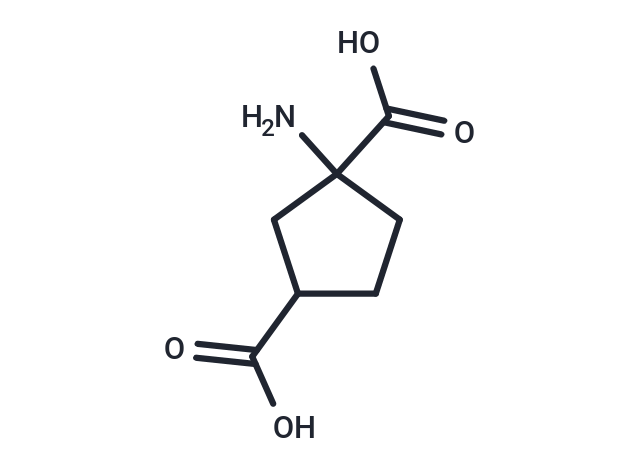Shopping Cart
- Remove All
 Your shopping cart is currently empty
Your shopping cart is currently empty
trans-ACPD ((±)-trans-ACPD) is an equimolecular mixture of (1S, 3R)- and (1R, 3S)-ACPD. trans-ACPD is a selective agonist of the mGluR (metabotropic glutamate receptor); active at the group I/II mGlu receptors (EC50: 2/15/23/800 μM, mGluR2/1/5/4).

| Pack Size | Price | Availability | Quantity |
|---|---|---|---|
| 1 mg | $41 | In Stock | |
| 2 mg | $57 | In Stock | |
| 5 mg | $91 | In Stock | |
| 10 mg | $150 | In Stock | |
| 25 mg | $293 | In Stock | |
| 50 mg | $531 | In Stock | |
| 100 mg | $768 | In Stock | |
| 1 mL x 10 mM (in DMSO) | $68 | In Stock |
| Description | trans-ACPD ((±)-trans-ACPD) is an equimolecular mixture of (1S, 3R)- and (1R, 3S)-ACPD. trans-ACPD is a selective agonist of the mGluR (metabotropic glutamate receptor); active at the group I/II mGlu receptors (EC50: 2/15/23/800 μM, mGluR2/1/5/4). |
| Targets&IC50 | mGluR1:15μM(EC50), mGluR2:2μM(EC50), mGluR5:23μM(EC50), mGluR4:800 μM(EC50) |
| In vitro | Excitatory amino acid (EAA) analogues activate receptors linked to increased hydrolysis of phosphoinositides (PIs). In these studies, hippocampal slices from neonatal rats (6-11 days old) characterize the effects of EAA analogues on these receptors. The EC50 value of trans-ACPD is 51 μM, and DL-2-Amino-3-phosphonopropionate (DL-AP3) serves as an equally potent inhibitor of PI hydrolysis induced by ibotenate, quisqualate, and trans-ACPD, with IC50 values ranging from 480 to 850 μM [2]. |
| In vivo | Intrathecal administration of NMDA, kainate, and trans-ACPD, along with the pro-inflammatory cytokines TNF-α or IL-1β, markedly increases biting behavior in mice, a paradigm shift from the control group receiving saline. Pre-systemic intervention with GM at a dosage of 100 mg/kg intraperitoneally notably decreases biting behavior in comparison to saline treatment (10 mL/kg, i.p.), with statistical significance (p<0.001). The efficacy of GM is particularly pronounced against pro-inflammatory cytokines and NMDA, exhibiting inhibition rates of TNF-α (92±7%), IL-1β (91±5%), NMDA (69±1%), and trans-ACPD (71±12%). Conversely, kainate-induced biting responses remain unaffected by GM at the same concentration. |
| Synonyms | Trans-(±)-ACP, 1-amino-1,3-dicarboxycyclopentane, (±)-trans-ACPD |
| Molecular Weight | 173.17 |
| Formula | C7H11NO4 |
| Cas No. | 67684-64-4 |
| Smiles | NC1(CCC(C1)C(O)=O)C(O)=O |
| Relative Density. | 1.452 g/cm3 (Predicted) |
| Storage | Powder: -20°C for 3 years | In solvent: -80°C for 1 year | Shipping with blue ice/Shipping at ambient temperature. | |||||||||||||||||||||||||||||||||||
| Solubility Information | 1eq. NaOH: 50 mM, Sonication is recommended. H2O: 5 mM, Heating is recommended. | |||||||||||||||||||||||||||||||||||
Solution Preparation Table | ||||||||||||||||||||||||||||||||||||
H2O/1eq. NaOH
1eq. NaOH
| ||||||||||||||||||||||||||||||||||||

Copyright © 2015-2025 TargetMol Chemicals Inc. All Rights Reserved.